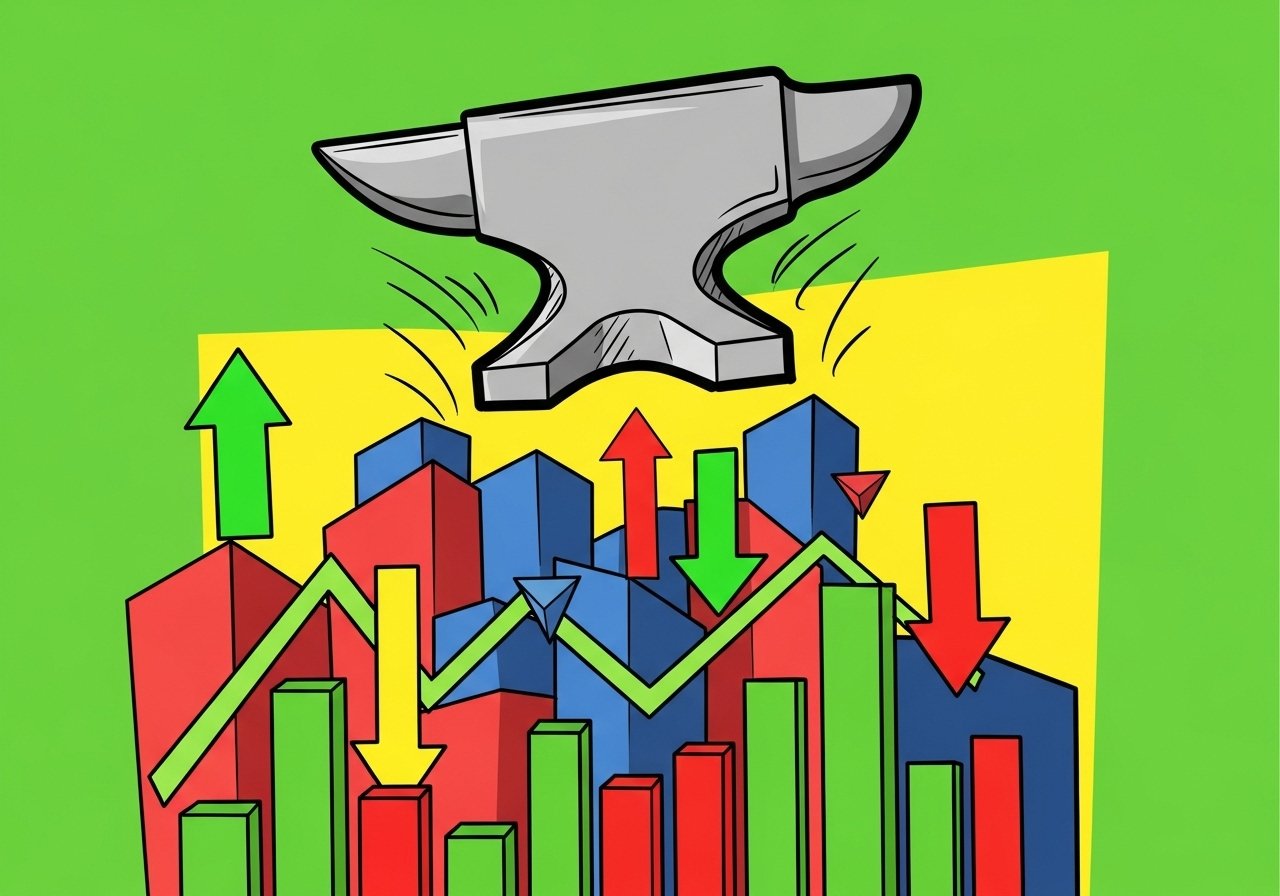What A Bad Day Taught Me About Diversification
PRESENTED BY SNOWBALL ANALYTICS
Disclaimer: This page contains some affiliate links that might just lead you to the promised land of awesomeness (or at least some cool products). I personally use all of the products promoted, and recommend them because they are companies I have found to be helpful and trustworthy. I may receive commissions for purchases made through links in this post.
Yesterday was just one of those days in the market where it felt like everything that could go wrong, did.
Starbucks (SBUX) reported their quarterly earnings, and the numbers sucked—there’s no other way to say it. EPS dropped 38% to $0.41, operating margin fell to 8.2%, and same-store sales were down 1% globally, including a 2% dip in the U.S.
Still, believe it or not, it does sound like some good things are percolating under the hood that suggest Starbucks might be heading in a better direction. We’ll just need more time to see how it all plays out.
The only real concern I have with the company right now is the payout ratio—it came in over 100% this quarter, which is a bit scary. That’s something I’ll be keeping a close eye on moving forward.
At any rate, as I’m sure you can imagine, the market didn’t love any of it. The stock dropped more than 5% for the day, which leaves the stock down about 17% just in the last 30 days. That’s a crazy drop for a big, blue-chip company like Starbucks—especially in such a short amount of time.
And then—because one gut punch wasn’t enough—a short report dropped on Clear Secure (YOU). These kinds of reports are designed to scare people, and they usually do a pretty good job of exactly that.
The people who write them are shorting the stock after all, so they have a clear incentive to get people to sell. Now that doesn’t mean all their arguments are false, but it does mean they’re highly motivated to paint the most bearish picture possible.
Thankfully, Clear didn’t get hit quite as hard as Starbucks, but it still added one more twist of the knife to an already uncomfortable day in the portfolio.
Days like those have a way of testing your mettle as an investor. It makes you think about a lot of things, which I did on a nice, long walk around my neighborhood.
In doing so, I thought a lot about diversification and the role it plays in my portfolio.
Now, Buffett and Munger have famously criticized broad diversification—calling it “protection against ignorance.” Buffett says it doesn’t make much sense if you truly know what you’re doing.
And for investors of their caliber, that’s probably true. They’ve spent an entire lifetime studying businesses more deeply than almost anyone else alive.
But for someone like me—who’s only been investing for a few years, didn’t study finance, and is still learning every day—it would be a bit too flattering (and a bit delusional) to think that same level of concentration would work in my favor.
That’s why I stay diversified. Not too much though—right now, I have 19 individual companies and 2 ETFs—but enough to give myself a comfortable cushion and to help me sleep at night when my portfolio turns into a punching bag.
Let’s say that worst-case scenario—and I mean absolute worst—Clear Secure goes to zero. That would certainly sting, and I’d be out a few thousand dollars, but it wouldn’t take me out of the game.
The same is true with Starbucks. I’d be hard pressed to believe Starbucks is going anywhere anytime soon, but even in some bizarre alternate reality where it does, my portfolio would still survive and recover.
And that’s the whole point of diversification. It doesn’t eliminate risk and the unforeseen, but it makes it survivable.
Now that doesn’t mean you need to own 100 different stocks—I don’t think that’s practical either. But there is a sort of diversification sweet spot—which for me, is somewhere in the range of 15 to 25 individual companies, plus my two ETFs.
Having said that, I want to hear from you: Where is your diversification sweet spot? Write to me here and let me know.
And if you want to learn about the new dividend stock I just recently added to my portfolio, then check out this video here.
Dividend Investing Democratized
Join thousands of savvy investors in the pursuit of early retirement. Get Retire With Ryne delivered straight to your inbox every week as you build your perpetually growing, cash-flowing dividend stock portfolio.
One of the most essential tools for any investor is a reliable portfolio tracker, and Snowball Analytics is the ultimate command center for your portfolio, providing all the tools you need (and more) in one place.
Plus, it’s one of the only portfolio trackers out there designed specifically for dividend investors.
The layout is clean and intuitive, offering charts, graphs, and other features you didn’t even know you needed but now can’t live without—like the event calendar, portfolio backtest tool, and the dip finder tool (this has been a game changer).
I’ve been using Snowball for a while now, and it's the most in-depth portfolio tracker I’ve ever used (you can see it in action here). I highly recommend it to any dividend investor looking for maximum functionality and data for tracking their portfolio.
Right now, Snowball Analytics is offering a 14-day FREE trial so you can try it out risk-free. The best part is, if you end up loving it (which, as you'll find out, is not hard to do), you can save 10% on your subscription when you use code “rynewilliams” upon signing up.
IN MY PORTFOLIO 📈
Start tracking your portfolio with Snowball Analytics today—free for 14 days! Plus, use code "rynewilliams" at checkout to get 10% off your subscription.
ICYMI 🎥
The Lonely Chapter of Investing | Ep. 16
In this episode of The Deep End, Ari and I dive into the idea of "The Lonely Chapter"—a period that every investor has to face at some point.
CAREFULLY CURATED 🔍
📺 A Cheap Stock Trick - Russ finally got around to reading Investing for Growth by Terry Smith, and in the process, picked up a fast and easy method for finding cheap stocks, which he shared with us here.
🎧 Steady Income, Shaky Economy - A fantastic episode of the Her Money podcast with Jenny Van Leeuwen Harrington, CEO of Gilman Hill Asset Management, who breaks down how you can build a dividend-focused portfolio tailored to your life and risk tolerance.
📚 A Few Short Stories - This blog post from Morgan Housel definitely lives up to its name, with each little story carrying its own big takeaway.
SINCE YOU ASKED 💬
"Ryne, you think you'll hit $125k this year?"
- Zachary | YouTube
I sure hope so! But it really depends on a few things.
First and foremost, it comes down to my contributions. Right now, I’m investing about $1,000 a month, so with roughly 8 months left in 2025, that alone should get me close to $100k—without factoring in dividends or any share price movement.
On the dividend side of things, I’ll probably pull in another $2,500 by the end of the year, which would bump me up to about $102.5k. That definitely helps, but it still leaves a $22.5k gap to hit $125k—which won’t be easy to fill.
I guess it’s still possible to get there if the market does a complete 180 and starts soaring the rest of the year. But realistically, I'd be surprised if that happened. I doubt I'll see another 20% in share price appreciation by December.
Having said that, getting to $125k would mean being a lot more aggressive with my contributions. Normally, I’d be all for that, but right now I’m trying to stash all my extra cash in a high-yield savings account, which I’m hoping to eventually use to buy more real estate.
Because of that, I’m not planning on throwing any extra money into my portfolio right now. Still, I’m feeling pretty confident I’ll at least hit $100k this year, and anything above that is just bonus points in my book.
There’s still a lot of year left, so we’ll see how it all shakes out!
Have a question? Ask me here to see it featured in an upcoming newsletter.






